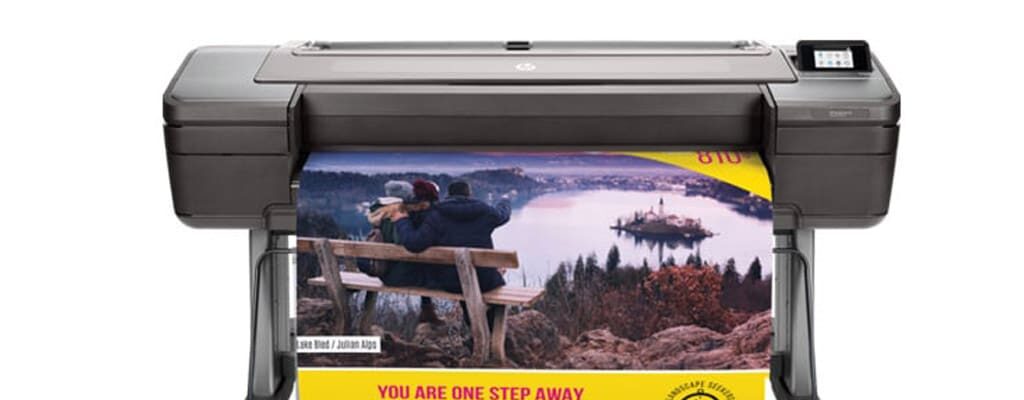What Can HP Wide Format Printers Print On? (Vinyl, Textiles, Wallpaper, or Polyester)
Contents
Wide-format printers are known for making great posters, banners, billboards, and signs. Yet, few people know what HP Wide Format Printers print on.
But few people know that some of the industry’s most reputable names manufacture wide-format solutions for printing on more than paper and vinyl substrates.
HP’s wide-format printers are designed for compatibility with a broad range of print media beyond paper. Some of the most common applications where you would want to print on a material other than paper include:
- Art reproduction
- Point of Purchase Displays
- Creative design applications
- Outdoor advertising
- Labels and packaging
- Trade show and event displays
There are virtually limitless options when it comes to HP’s wide-format media compatibility. The company’s wide format product printers, PageWide, and their light production printers, DesignJet, are the perfect options for businesses looking for wallpaper or polyester applications.
The key is choosing the right printer for the job.
The Diversity of HP Wide Format Printers
HP Wide Format Printers can print on a variety of materials, including vinyl, textiles, wallpaper, and polyester. This versatility makes them suitable for diverse applications, such as signage, banners, and custom decor. Here are examples of different uses:
Vinyl
Ideal for banners, decals, and outdoor signage due to its durability and weather resistance.
Textiles
Used for printing on fabrics like canvas or polyester, perfect for custom apparel, home decor, and banners.
Wallpaper
Custom wallpaper prints for interior design, allowing for personalized decor and branding in commercial spaces.
Polyester
Often used for lightweight banners, flags, and backdrops, offering vibrant colors and durability.
These materials expand creative possibilities and practical applications across industries.
HP Prints on Vinyl
One of the most popular substrates that print process owners experiment with is vinyl. Creating a self-adhesive vinyl sticker allows you to turn nearly any product into a branded marketing tool.
HP Designjet printers support vinyl substrates, printing crisp, perfect images with clarity and color depth. The key to making the most of a wide-format printer and vinyl combination is choosing the right ink for the process.
Look for inks that use pigmented inks for extra vinyl durability. While standard inks will image beautifully, it will lack water resistance for outdoor applications.
HP Prints on Light Fabric
The same HP PageWide and DesignJet printers that marketers and advertisers use to create vinyl banners can also complete textiles and polyester prints. Using a special wrinkle-resistant and flame-resistant material called HP Light Fabric, it’s possible to upgrade your capabilities without having to purchase new print equipment beyond your standard HP wide-format printer.
Custom digital fabric printing is transforming the market as increasing numbers of print operators turn to high-margin printing opportunities in the world of retail and marketing. Some businesses are using this technology to create customized interior design packages – the possibilities of this newly efficient technology have not yet been fully explored.
This technology makes the purchase of an HP PageWide or DesignJet printer a value generator that few businesses can pass up. If you regularly contract print jobs out to specialists only because you can’t print on a wide variety of materials, HP technology can provide you with the efficient, low-cost solutions.
Ink Choice Matters for All Substrates
As with any substrate, the choice of ink is an important determinant in overall print quality. The DesignJet T series offers standard dye based color ink and pigmented black. This gives you the ability to do vibrant color for day-to-day printing and water fast capabilities for your monochrome documents.
The DesignJet Z series and the Pagewide XL printers work with pigmented inks. Pigmented inks are not water-soluble so they offer advantages such as longer lasting prints, better color stability, fade resistance and smudge & water resistance. When used with waterproof media, you can product a waterproof print which is especially useful in outdoor applications.
It is not always the case that the most expensive ink, used at the highest possible resolution, is the best imaging option for any given project. A vinyl banner sign set 50 feet away from its traffic zone does not need to have the clarity and depth of color that your corporate logo in the lobby does. Choosing the right printer, ink, and imaging settings on a project-by-project basis is the best way to ensure long-lasting and satisfying results.



